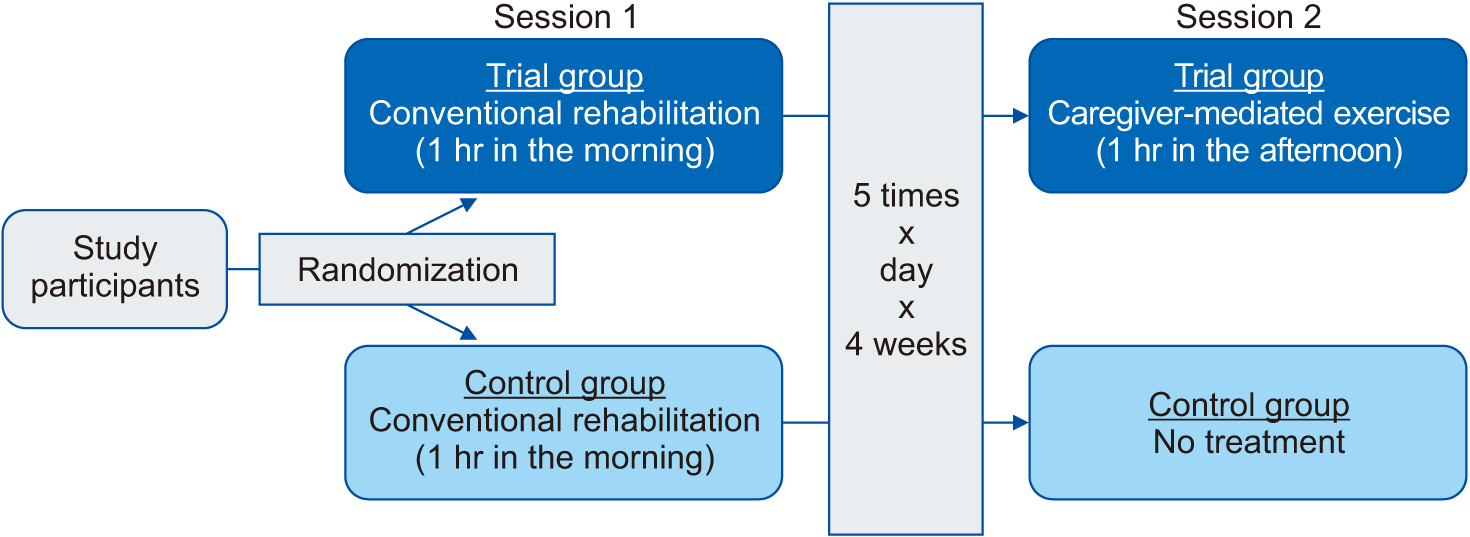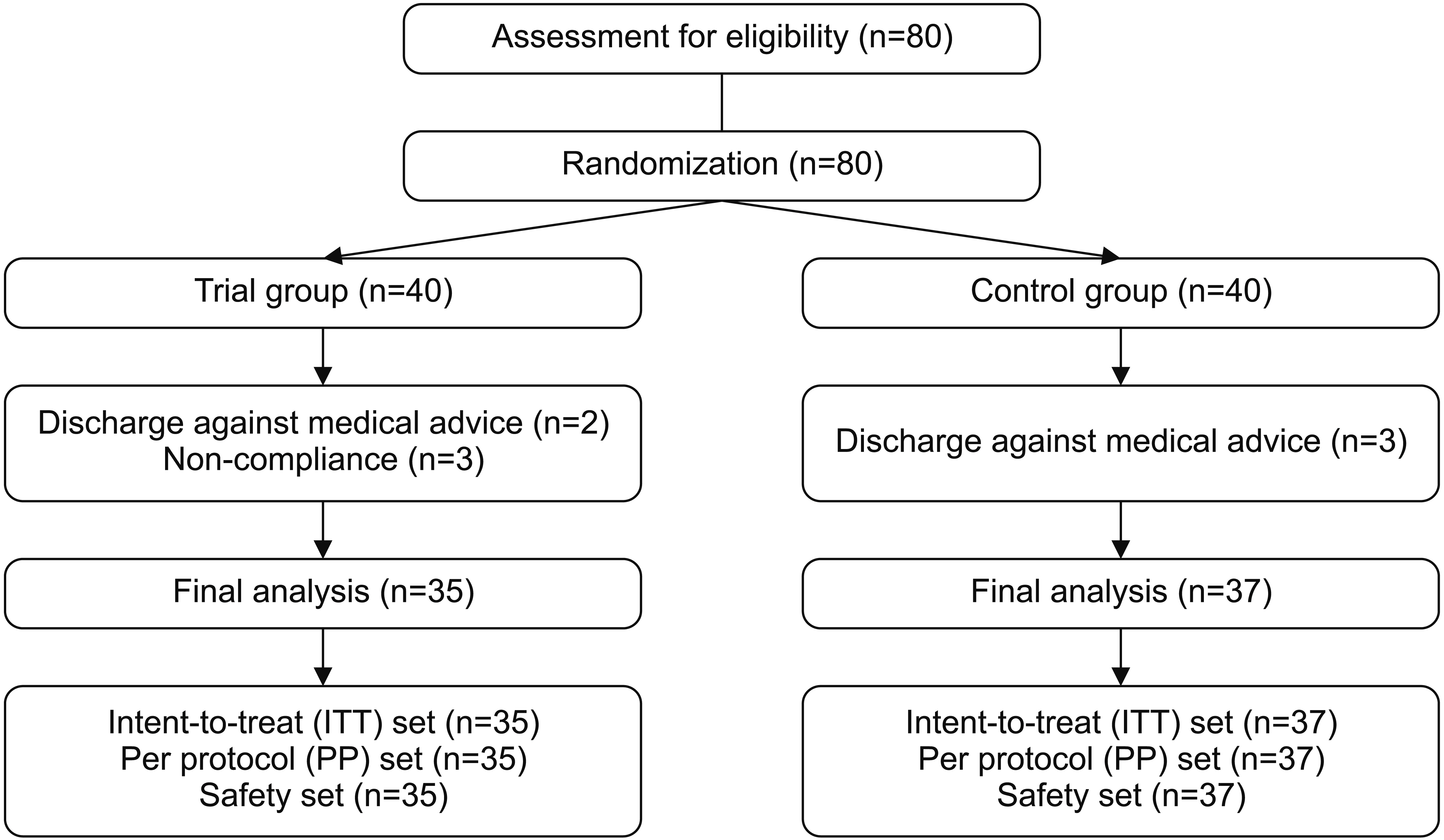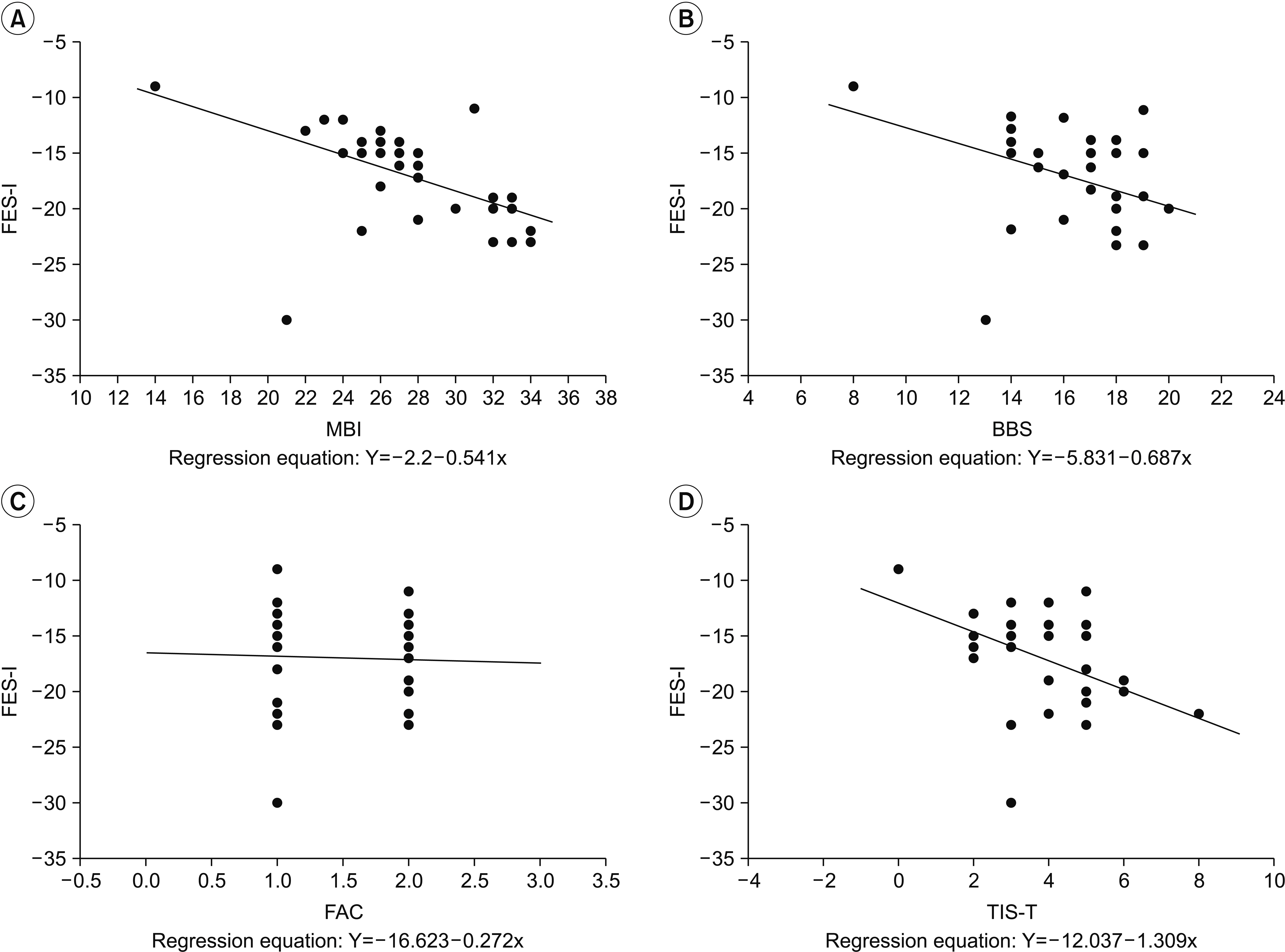Ann Rehabil Med.
2018 Jun;42(3):406-415. 10.5535/arm.2018.42.3.406.
Efficacy and Safety of Caregiver-Mediated Exercise in Post-stroke Rehabilitation
- Affiliations
-
- 1Department of Rehabilitation Medicine, Konkuk University Chungju Hospital, Chungju, Korea. skysea333@hanmail.net
- KMID: 2417832
- DOI: http://doi.org/10.5535/arm.2018.42.3.406
Abstract
OBJECTIVE
To assess the efficacy and safety of our 4-week caregiver-mediated exercise (CME) in improving trunk control capacity, gait, and balance and in decreasing concerns about post-stroke falls when there is an increase in its efficacy.
METHODS
Acute or subacute stroke survivors were assigned to either the trial group (n=35) or the control group (n=37). Changes in Modified Barthel Index (MBI), Functional Ambulation Categories (FAC), Berg Balance Scale (BBS), and Trunk Impairment Scale (TIS) scores at 4 weeks from baseline served as primary outcome measures. Correlations of primary outcome measures with changes in Fall Efficacy Scale-International (FES-I) scores at 4 weeks from baseline in the trial group served as secondary outcome measures. Treatment-emergent adverse events (TEAEs) served as safety outcome measures.
RESULTS
There were significant differences in changes in MBI, FAC, BBS, TIS-T, TIS-D, TIS-C, and FES-I scores at 4 weeks from baseline between the two groups (all p < 0.0001). There were no significant (p=0.0755) differences in changes in TIS-S scores at 4 weeks from baseline between the two groups. MBI, FAC, BBS, and TIS scores showed significantly inverse correlations with FES-I scores in patients receiving CME. There were no TEAEs in our series.
CONCLUSION
CME was effective and safe in improving the degree of independence, ambulation status, dynamic and static balance, trunk function, and concerns about post-stroke falls in stroke survivors.
Keyword
MeSH Terms
Figure
Reference
-
1. Vloothuis J, Mulder M, Nijland RH, Konijnenbelt M, Mulder H, Hertogh CM, et al. Caregiver-mediated exercises with e-health support for early supported discharge after stroke (CARE4STROKE): study protocol for a randomized controlled trial. BMC Neurol. 2015; 15:193.
Article2. Belgen B, Beninato M, Sullivan PE, Narielwalla K. The association of balance capacity and falls self-efficacy with history of falling in community-dwelling people with chronic stroke. Arch Phys Med Rehabil. 2006; 87:554–61.
Article3. Zijlstra GA, van Haastregt JC, van Rossum E, van Eijk JT, Yardley L, Kempen GI. Interventions to reduce fear of falling in community-living older people: a systematic review. J Am Geriatr Soc. 2007; 55:603–15.
Article4. Pajala S, Era P, Koskenvuo M, Kaprio J, Tormakangas T, Rantanen T. Force platform balance measures as predictors of indoor and outdoor falls in communitydwelling women aged 63-76 years. J Gerontol A Biol Sci Med Sci. 2008; 63:171–8.
Article5. Kosse NM, de Groot MH, Vuillerme N, Hortobagyi T, Lamoth CJ. Factors related to the high fall rate in longterm care residents with dementia. Int Psychogeriatr. 2015; 27:803–14.
Article6. Forster A, Young J. Incidence and consequences of falls due to stroke: a systematic inquiry. BMJ. 1995; 311:83–6.7. Nyberg L, Gustafson Y. Patient falls in stroke rehabilitation: a challenge to rehabilitation strategies. Stroke. 1995; 26:838–42.8. Vlahov D, Myers AH, Al-Ibrahim MS. Epidemiology of falls among patients in a rehabilitation hospital. Arch Phys Med Rehabil. 1990; 71:8–12.9. Teasell R, McRae M, Foley N, Bhardwaj A. The incidence and consequences of falls in stroke patients during inpatient rehabilitation: factors associated with high risk. Arch Phys Med Rehabil. 2002; 83:329–33.
Article10. Di Monaco M, Trucco M, Di Monaco R, Tappero R, Cavanna A. The relationship between initial trunk control or postural balance and inpatient rehabilitation outcome after stroke: a prospective comparative study. Clin Rehabil. 2010; 24:543–54.
Article11. Verheyden G, Vereeck L, Truijen S, Troch M, Herregodts I, Lafosse C, et al. Trunk performance after stroke and the relationship with balance, gait and functional ability. Clin Rehabil. 2006; 20:451–8.
Article12. Dault MC, de Haart M, Geurts AC, Arts IM, Nienhuis B. Effects of visual center of pressure feedback on postural control in young and elderly healthy adults and in stroke patients. Hum Mov Sci. 2003; 22:221–36.
Article13. Chou SW, Wong AM, Leong CP, Hong WS, Tang FT, Lin TH. Postural control during sit-to stand and gait in stroke patients. Am J Phys Med Rehabil. 2003; 82:42–7.
Article14. Mehrholz J, Pohl M, Elsner B. Treadmill training and body weight support for walking after stroke. Cochrane Database Syst Rev. 2014; (1):CD002840.
Article15. Verheyden G, Vereeck L, Truijen S, Troch M, Lafosse C, Saeys W, et al. Additional exercises improve trunk performance after stroke: a pilot randomized controlled trial. Neurorehabil Neural Repair. 2009; 23:281–6.
Article16. English C, Shields N, Brusco NK, Taylor NF, Watts JJ, Peiris C, et al. Additional weekend therapy may reduce length of rehabilitation stay after stroke: a metaanalysis of individual patient data. J Physiother. 2016; 62:124–9.
Article17. Vloothuis JD, Mulder M, Veerbeek JM, Konijnenbelt M, Visser-Meily JM, Ket JC, et al. Caregiver-mediated exercises for improving outcomes after stroke. Cochrane Database Syst Rev. 2016; 12:CD011058.
Article18. Visser-Meily A, Post M, Gorter JW, Berlekom SB, Van Den Bos T, Lindeman E. Rehabilitation of stroke patients needs a family-centred approach. Disabil Rehabil. 2006; 28:1557–61.
Article19. Galvin R, Cusack T, Stokes E. To what extent are family members and friends involved in physiotherapy and the delivery of exercises to people with stroke? Disabil Rehabil. 2009; 31:898–905.
Article20. Cobley CS, Fisher RJ, Chouliara N, Kerr M, Walker MF. A qualitative study exploring patients’ and carers’ experiences of Early Supported Discharge services after stroke. Clin Rehabil. 2013; 27:750–7.
Article21. Scherer MJ, Craddock G, Mackeogh T. The relationship of personal factors and subjective well-being to the use of assistive technology devices. Disabil Rehabil. 2011; 33:811–7.
Article22. Liao CD, Liou TH, Huang YY, Huang YC. Effects of balance training on functional outcome after total knee replacement in patients with knee osteoarthritis: a randomized controlled trial. Clin Rehabil. 2013; 27:697–709.
Article23. Verheyden G, Nieuwboer A, Mertin J, Preger R, Kiekens C, De Weerdt W. The Trunk Impairment Scale: a new tool to measure motor impairment of the trunk after stroke. Clin Rehabil. 2004; 18:326–34.
Article24. Morgan MT, Friscia LA, Whitney SL, Furman JM, Sparto PJ. Reliability and validity of the Falls Efficacy Scale-International (FES-I) in individuals with dizziness and imbalance. Otol Neurotol. 2013; 34:1104–8.
Article25. Sakpal TV. Sample size estimation in clinical trial. Perspect Clin Res. 2010; 1:67–9.26. van de Port IG, Kwakkel G, Schepers VP, Lindeman E. Predicting mobility outcome one year after stroke: a prospective cohort study. J Rehabil Med. 2006; 38:218–23.
Article27. Kollen B, van de Port I, Lindeman E, Twisk J, Kwakkel G. Predicting improvement in gait after stroke: a longitudinal prospective study. Stroke. 2005; 36:2676–80.28. Dobkin BH, Nadeau SE, Behrman AL, Wu SS, Rose DK, Bowden M, et al. Prediction of responders for outcome measures of Locomotor Experience Applied Post Stroke trial. J Rehabil Res Dev. 2014; 51:39–50.
Article29. Scholte op Reimer WJ, de Haan RJ, Rijnders PT, Limburg M, van den Bos GA. The burden of caregiving in partners of long-term stroke survivors. Stroke. 1998; 29:1605–11.
Article30. Duncan PW, Zorowitz R, Bates B, Choi JY, Glasberg JJ, Graham GD, et al. Management of adult stroke rehabilitation care: a clinical practice guideline. Stroke. 2005; 36:e100. –43.31. Miller EL, Murray L, Richards L, Zorowitz RD, Bakas T, Clark P, et al. Comprehensive overview of nursing and interdisciplinary rehabilitation care of the stroke patient: a scientific statement from the American Heart Association. Stroke. 2010; 41:2402–48.32. Kalra L, Evans A, Perez I, Melbourn A, Patel A, Knapp M, et al. Training carers of stroke patients: randomised controlled trial. BMJ. 2004; 328:1099.
Article33. Wang TC, Tsai AC, Wang JY, Lin YT, Lin KL, Chen JJ, et al. Caregiver-mediated intervention can improve physical functional recovery of patients with chronic stroke: a randomized controlled trial. Neurorehabil Neural Repair. 2015; 29:3–12.34. Galvin R, Cusack T, O’Grady E, Murphy TB, Stokes E. Family-mediated exercise intervention (FAME): evaluation of a novel form of exercise delivery after stroke. Stroke. 2011; 42:681–6.35. Blennerhassett J, Dite W. Additional task-related practice improves mobility and upper limb function early after stroke: a randomised controlled trial. Aust J Physiother. 2004; 50:219–24.
Article36. Galvin R, Murphy B, Cusack T, Stokes E. The impact of increased duration of exercise therapy on functional recovery following stroke: what is the evidence? Top Stroke Rehabil. 2008; 15:365–77.37. Kwakkel G, van Peppen R, Wagenaar RC, Wood Dauphinee S, Richards C, Ashburn A, et al. Effects of augmented exercise therapy time after stroke: a metaanalysis. Stroke. 2004; 35:2529–39.38. Kwakkel G. Impact of intensity of practice after stroke: issues for consideration. Disabil Rehabil. 2006; 28:823–30.
Article39. Cooke EV, Mares K, Clark A, Tallis RC, Pomeroy VM. The effects of increased dose of exercise-based therapies to enhance motor recovery after stroke: a systematic review and meta-analysis. BMC Med. 2010; 8:60.
Article
- Full Text Links
- Actions
-
Cited
- CITED
-
- Close
- Share
- Similar articles
-
- An Effects of Aquatic Exercise on in Home Stroke Patients
- The Relationship between the Characteristics of Social Support and Post-Stroke Depression
- Safety and effectiveness of early cardiac rehabilitation in a stroke patient with heart failure and atrial fibrillation: a case report
- The Effect of Post-Stroke Depression on Rehabilitation Outcome and the Impact of Caregiver Type as a Factor of Post-Stroke Depression
- The Effects of Community-Based Self-Help Management Program by Strengthening Self-Efficacy of Post Stroke Elderly Patients




